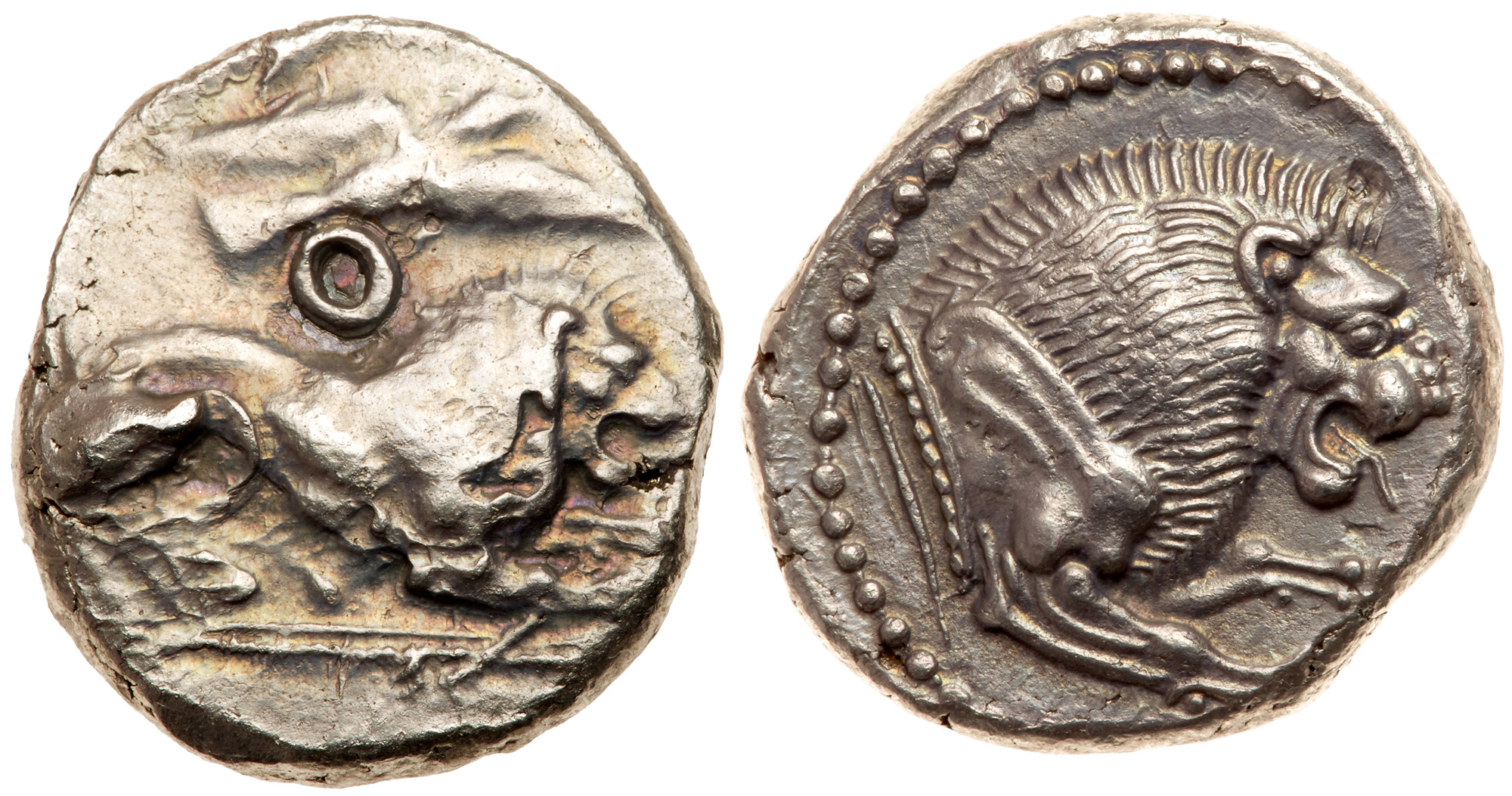449 BCE - 425 BCE | L'Z'B'L (in Aramaic)
Overstriking coin
Citium_over_Amathus_Nomos, _20, _10_July_2020, _254.jpg
[1]
Overstruck variety
Amathus under Citium.jpg
[2]
Description
| ObverseInscription or printing placed on the obverse.:
|
Herakles, wearing lion skin, in fighting stance right, holding club and bow
|
ReverseInscription or printing placed on the reverse.:
|
L'Z'B'L (in Aramaic) (Aramaic) Lion attacking stag crouching right within incuse square.
|
Mint and issuing power
Chronology
| FromIdentifies the initial date in a range assigned in a numismatic context. 449 BCE toIdentifies the final date in a range assigned in a numismatic context.. 425 BCE
|
Classical 480-323 BC  periodTime period of the numismatic object. periodTime period of the numismatic object.
|
Physical description
MetalThe physical material (usually metal) from which an object is made.: Silver 
|
WeightWeight of the numismatic object (in grams). in grams: 10.9410.94 g <br />10,940 mg <br />
|
DenominationTerm indicating the value of a numismatic object. Examples: tetradrachm, chalkous, denarius.: double siglos 
|
AxisDescribes the directional relationship between the obverse and reverse of a numismatic object.: 66 mm <br />0.6 cm <br />
|
| DiameterDescribes diameter of an object (in mm).: 2626 mm <br />2.6 cm <br />
|
StandardStandard.: Persian
|
References
Description
| ObverseInscription or printing placed on the obverse.:
|
Lion crouching right, above, eagle flying right, between lion and eagle
|
ReverseInscription or printing placed on the reverse.:
|
Forepart of lion right, with mouth agape
|
Mint and issuing power
| MintIdentifies the place of manufacture or issue of a numismatic object. ᵖ:
|
Amathus
|
Ancient regionAncient region. ᵖ
|
Cyprus
|
Modern countryModern country: Greece
|
AuthorityIdentifies the authority in whose name (explicitly or implicitly) a numismatic object was issued. ᵖ:
|
|
Chronology
| FromIdentifies the initial date in a range assigned in a numismatic context. 450 BCE toIdentifies the final date in a range assigned in a numismatic context.. 435 BCE
|
Classical 480-323 BC  periodTime period of the numismatic object. periodTime period of the numismatic object.
|
Physical description
| DenominationTerm indicating the value of a numismatic object. Examples: tetradrachm, chalkous, denarius. ᵖ:
|
double siglos 
|
StandardStandard. ᵖ:
|
Persian
|
References
| Frequency of overstrikesFrequency of overstrikes:
|
frequent
|
Level of confidenceLevel of confidence of the identification:
|
sure
|
| RemarksRemarks:
|
"An interesting coin, overstruck on a near contemporary coin of Amathus, as Amandry 126A, dated to 450-430 BC. Struck from a heavily worn obverse die and with considerable traces of overstriking"
|
References
- ^ Wroth, Warwick William (1886), A Catalogue of the Greek coins in the British Museum. vol. X : Crete and the Aegean Islands, London, The Trustees, p. 152, pl. XXIX
- a b Tziambazis, Elias (2002), A catalogue of the coins of Cyprus: from 560 B.C. to 1571 A.D., Larnaca, 89 p.
- ^ Zapiti, Eleni - Michaelidou, Lefki (2008), Coins of Cyprus : from the collection of the Bank of Cyprus Cultural Foundation, Nicosia, Bank of Cyprus Cultural Foundation, 329 p.

